- You are here:
- Home »
- Blog
- Archive:
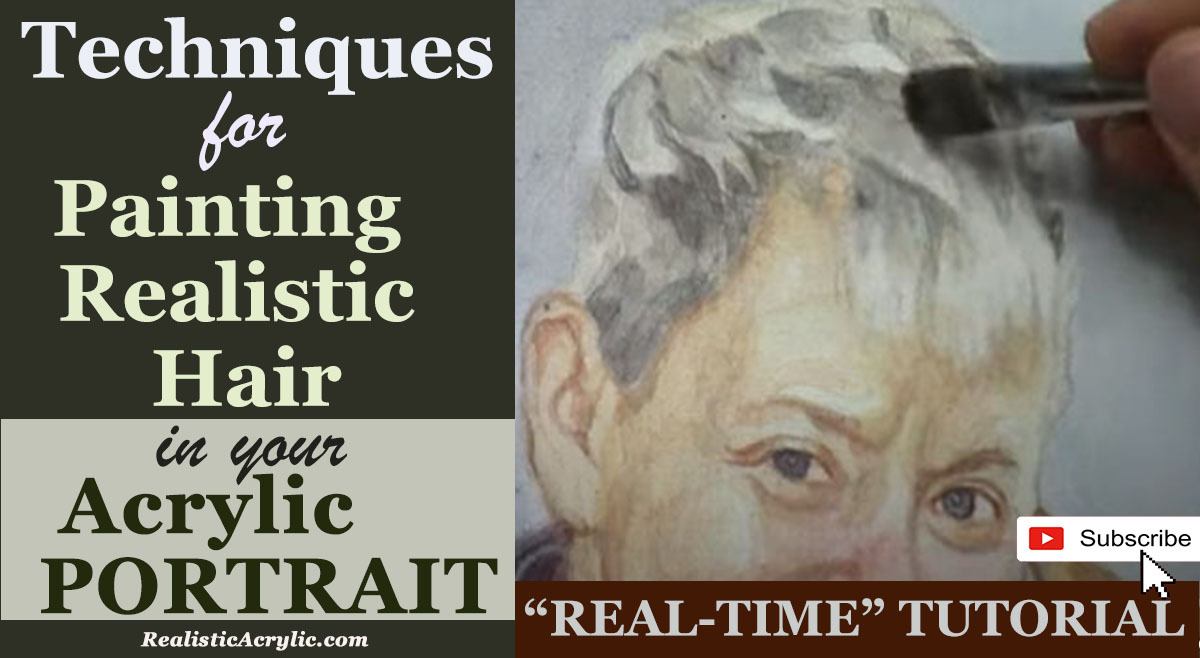
How to Paint Realistic Hair in Acrylic Portrait
Creating lifelike hair in acrylic portraits by using simple layering and glazing techniques.
Creating realistic hair in acrylic portraits can be challenging for many artists. However, with a few foundational techniques like glazing, layering, and understanding value shapes, the task becomes much more manageable. In this guide, I’ll walk you through the step-by-step process on how to paint realistic hair in an acrylic portrait, focusing on how to build depth, enhance vibrance, and add nuances through layering.
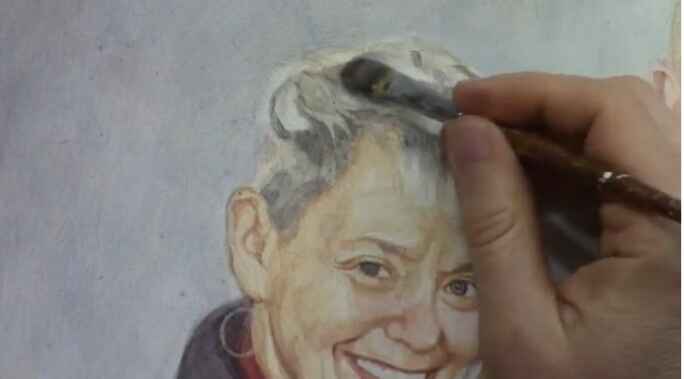
1. Understanding Glazing for Realism
The glazing technique is an excellent way to create depth, vibrance, and smooth transitions in acrylic paintings. It allows the artist to build color slowly, using thin layers of semi-transparent paint to adjust tones and values. When light shines through these layers, the colors appear richer, resembling the look of oil paintings.
For this portrait of a couple and their cat, I used this method extensively to paint their hair. The first step is to establish a light sketch on the canvas. Then, using multiple thin layers of paint, I gradually build up the color and value of the hair, which creates the illusion of volume and movement.
Tip:
Use a matte medium with your acrylic paint to make it more fluid without diluting the color too much, unlike water.
2. Layering and Building Gradually
Think of painting hair as similar to developing a photograph each layer adds more clarity. When painting hair, you don’t have to finish one section entirely before moving on. Instead, build the entire hair section up gradually with layers. This approach allows you to create smoother transitions between light and shadow, which is key to making the hair look realistic.
In the example of this painting, I began by blocking in mid-tone values, using a combination of burnt sienna, ultramarine blue, and raw umber. The dark tones in the hair were added in stages, with lighter highlights being reserved for later layers.
Tip:
Don’t be afraid to layer over your previous work. Acrylics dry quickly, making them ideal for building layers that add depth and realism.
3. Breaking Hair Down Into Shapes
One of the biggest challenges artists face when painting hair is getting overwhelmed by the fine details. Instead of trying to capture every single strand, think of the hair as a collection of abstract shapes. These shapes represent the shadows, mid-tones, and highlights within the hair.
As a result of focusing on these larger forms, you can create a more structured and realistic base. Because in this video, I demonstrate how to break down the hair into different value shapes, comparing them to geographical features like states and continents. This method helps simplify the process, making the task of painting hair less daunting.
Tip:
Don’t paint hair as individual strands. Instead, focus on grouping them into sections that follow the flow of the hairstyle.
4. Darkening and Adding Richness
Once the base shapes of the hair are laid out, the next step is to start adding depth by darkening certain areas. In this case, I used a mix of raw umber and ultramarine blue to darken the upper sections of the hair, creating contrast against the lighter highlights. Then the darker areas serve to define the shape of the hair, giving it a three-dimensional appearance.
The richness and depth of the hair are enhanced by applying glazes of semi-transparent paint. Then the glazing technique ensures that the darker tones blend seamlessly with the lighter ones, avoiding harsh transitions.
Tip:
Use a filbert brush to help blend the paint smoothly, especially when working on transitions between light and shadow.
5. Adding Highlights and Nuances
Lastly, the final step is to add the highlights and small nuances that bring the hair to life. Because highlights should be placed strategically to mimic the way light interacts with the hair. In this portrait, I used a small round brush to carefully apply titanium white mixed with a bit of yellow to the lighter sections of the hair. These highlights are what give the hair its shine and texture.
Tip:
Apply highlights sparingly and blend them gently into the surrounding areas to avoid a stark, unnatural look.
6. Creating Depth Through Value Shapes
An important concept to remember when painting hair is that it’s all about value shapes. Because value refers to the lightness or darkness of a color, and by using a range of values, you can create depth and form. In the painting, the hair was broken down into sections of dark, mid-tone, and light values, much like a map with different regions. Each value shape contributes to the overall structure of the hair, making it appear more realistic.
Tip:
Think of value shapes as the backbone of your painting. They give structure and guide the placement of details like highlights and shadows.
Conclusion
Painting realistic hair in acrylic portraits may seem challenging, but by following these techniques glazing, layering, and focusing on value shapes you can achieve beautiful, lifelike results. Remember to approach the task patiently, building up the hair gradually through multiple layers, and breaking the complexity of the hair into manageable shapes.
Because by practicing these methods, you’ll be able to create hair that looks natural and three dimensional in your portraits. Then, with time and dedication, the process will become second nature, and you’ll find joy in bringing your acrylic portraits to life.
If you found this guide helpful and would like to learn more about sketching or painting techniques, visit realisticacrylic.com for more tutorials and check out my free gift for you here.
- Adding highlights to your acrylic painting
- 5 Excellent Reasons to Use Aluminum Foil
- Paint Realistic Wrinkles in Acrylic
- Painting Clothing in an Acrylic Portrait
- Paint a Cloudy Sky Acrylic
- How to add Semi-Opaque Highlights
- How to Enhance the Contrast in Your Acrylic
- How to Add Glaze to Your Acrylic Painting
- Paint Realistic Reflections on Eyeglasses in an Acrylic Portrait
- Build Up Depth on Your Acrylic Portrait Backgrounds
- How Do You Do Layers With the Glazing Technique?
- Learn How to Paint Wrinkles in Acrylic
Read more about how to paint a portrait that you can surely be proud of!
I’d love to hear your thoughts on this video. Please share it with your friends and family. Let me know if you have any further questions. I’ll greatly help you.
If you’d like to learn more, sign up for my free email tips and video class today.
Learn How to Paint Acrylic Portraits With My Free Mini-Video Course!
Thank you so much for taking the time to read this tutorial and watch the video. That means a lot to me. I hope you find it very helpful in your portrait painting.
Yours for Better Portraits,

P.S. Did you find this post helpful or encouraging? If so, send it on ahead! Let others know with the share buttons below. I’d love to hear your comments. Thank you so much! Also, do you have a question on acrylic portrait painting you’d like answered? Let me know, and I’d be happy to help!
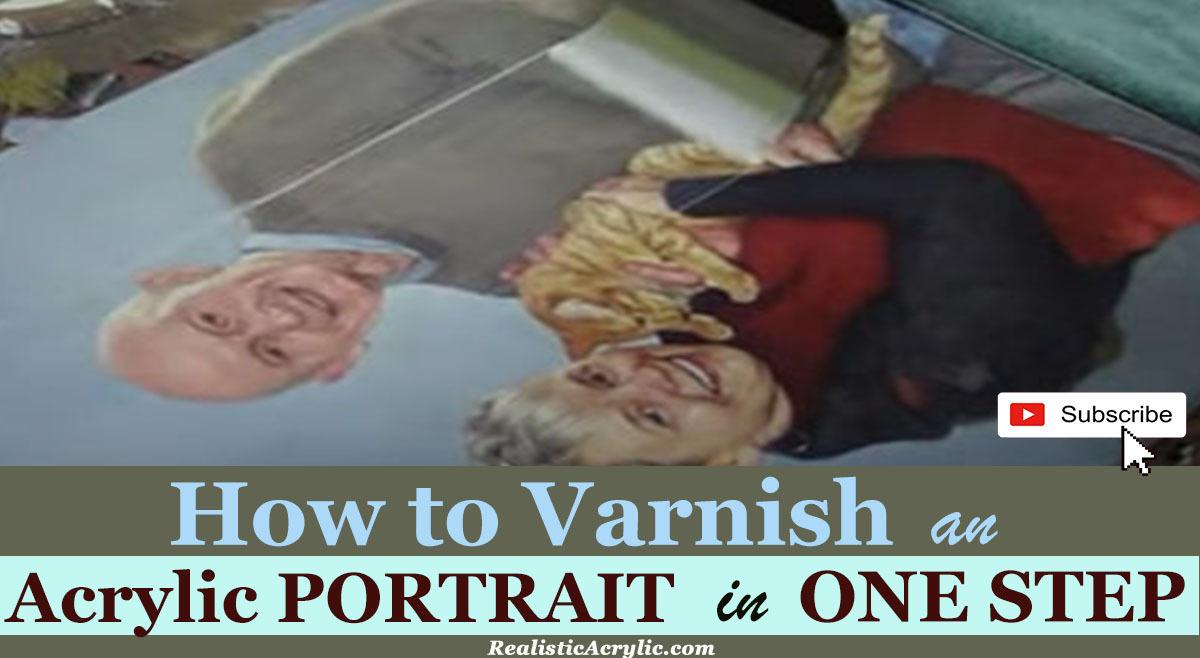
How to Varnish an Acrylic Portrait in ONE STEP
Learn the simple, foolproof method to varnish your acrylic portraits in one step, ensuring protection, enhanced color, and a professional finish.
When you’ve completed an acrylic portrait, you want to make sure it stands the test of time. Varnishing your artwork is the final touch that not only protects it but also enhances its appearance. Because in this tutorial, we’ll walk you through how to varnish an acrylic portrait in the one-step process, ensuring a professional, smooth finish every time.
Whether you’re new to varnishing or a seasoned artist, this simple technique will leave your acrylic portraits looking polished and ready to shine for years to come.
Why Varnishing Is Essential
Varnishing is often overlooked but is one of the most important steps in preserving your acrylic portraits. Here’s why you should varnish:
- Protection from Dust and Dirt: Varnish acts as a shield, protecting your painting from dirt, dust, and other environmental factors that could damage it over time.
- Prevents Scratches: It adds a layer of defense against accidental scuffs or scratches.
- Enhances Color and Depth: Varnish can bring out the depth and vibrancy in your colors, making your painting look more saturated and alive.
- Even Sheen for a Professional Finish: A good varnish gives your painting a consistent sheen, making it look more professional.
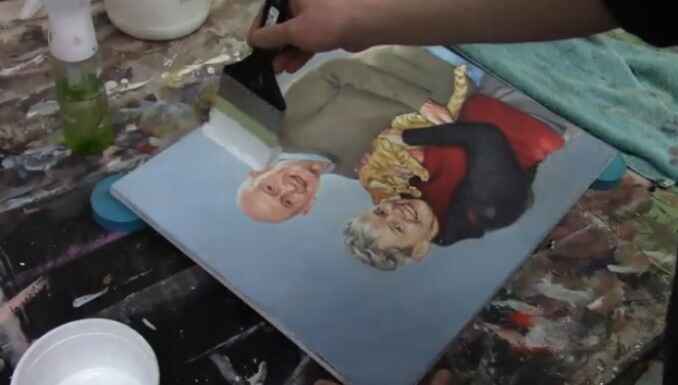
Preparing Your Workspace
Before you begin the varnishing process, it’s important to set up a clean, flat workspace. Unlike painting, where working vertically on an easel is common, varnishing must be done on a horizontal surface. If your painting is at an angle, the varnish can drip and dry unevenly, ruining the finish.
Step 1: Lay Your Painting Flat
Then place your painting on a flat table. To avoid picking up dust or dirt from the surface, elevate the canvas slightly. You can use items like jar lids or small wooden blocks to lift it off the table.
Step 2: Gather Your Materials
Here’s what you’ll need:
- Matte Varnish: For this tutorial, we recommend Nova Color Matte Varnish. Although labeled as matte, it dries to a satin finish, giving your painting a subtle sheen.
- Gloss Medium (Optional): Adding a bit of gloss medium (around 15%) can increase the shine of the varnish, giving it more vibrancy.
- Wide Flat Brush: A 10-inch flat brush works best for larger portraits (16×20 inches). For smaller portraits, use a 2-inch flat brush.
- Towel: Keep a towel nearby to wipe excess varnish from the brush.
Mixing and Preparing the Varnish
Step 1: Stir, Don’t Shake
Pour your varnish into a container, such as a clean yogurt container. Add about 15% gloss medium if you want a shinier finish. Use a whisk or a paint stir stick to thoroughly mix the varnish. Avoid shaking the container, as this can create bubbles that may affect the smoothness of the finish.
Step 2: Prepare Your Brush
Before dipping your brush into the varnish, lightly mist the bristles with water. This helps the varnish spread more evenly across the canvas.
Applying the Varnish
Step 1: Start in Sections
Dip your brush into the varnish, ensuring it’s evenly coated but not overloaded. When you start by applying the varnish about one-third of the way down the canvas. Brush in even strokes from top to bottom, making sure to overlap each section slightly.
Step 2: Use Long, Even Strokes
In this case, as you varnish, use long, smooth strokes to spread the varnish across the painting. Flip your brush over occasionally to ensure an even distribution. Avoid pressing too hard, as this can create streaks.
Step 3: Avoid Over-Brushing
One of the most common mistakes when varnishing is over-brushing. After applying the varnish in a few strokes, resist the urge to keep going over the same areas. Even if the varnish appears streaky or cloudy at first, it will dry clear. Over-brushing can cause the varnish to become uneven and may introduce unwanted bubbles.
If you’re looking for more instructional videos on how to improve your acrylic painting, visit www.realisticacrylic.com for more tutorials and check out my free courses here. .
- Adding highlights to your acrylic painting
- 5 Excellent Reasons to Use Aluminum Foil
- Paint Realistic Wrinkles in Acrylic
- Painting Clothing in an Acrylic Portrait
- Paint a Cloudy Sky Acrylic
- How to add Semi-Opaque Highlights
- How to Enhance the Contrast in Your Acrylic
- How to Add Glaze to Your Acrylic Painting
- Paint Realistic Reflections on Eyeglasses in an Acrylic Portrait
- Build Up Depth on Your Acrylic Portrait Backgrounds
- How Do You Do Layers With the Glazing Technique?
- Learn How to Paint Wrinkles in Acrylic
Read more about how to paint a portrait that you can surely be proud of!
I’d love to hear your thoughts on this video. Please share it with your friends and family. Let me know if you have any further questions. I’ll greatly help you.
If you’d like to learn more, sign up for my free email tips and video class today.
Learn How to Paint Acrylic Portraits With My Free Mini-Video Course!
Thank you so much for taking the time to read this tutorial and watch the video. That means a lot to me. I hope you find it very helpful in your portrait painting.
Yours for Better Portraits,

P.S. Did you find this post helpful or encouraging? If so, send it on ahead! Let others know with the share buttons below. I’d love to hear your comments. Thank you so much! Also, do you have a question on acrylic portrait painting you’d like answered? Let me know, and I’d be happy to help!
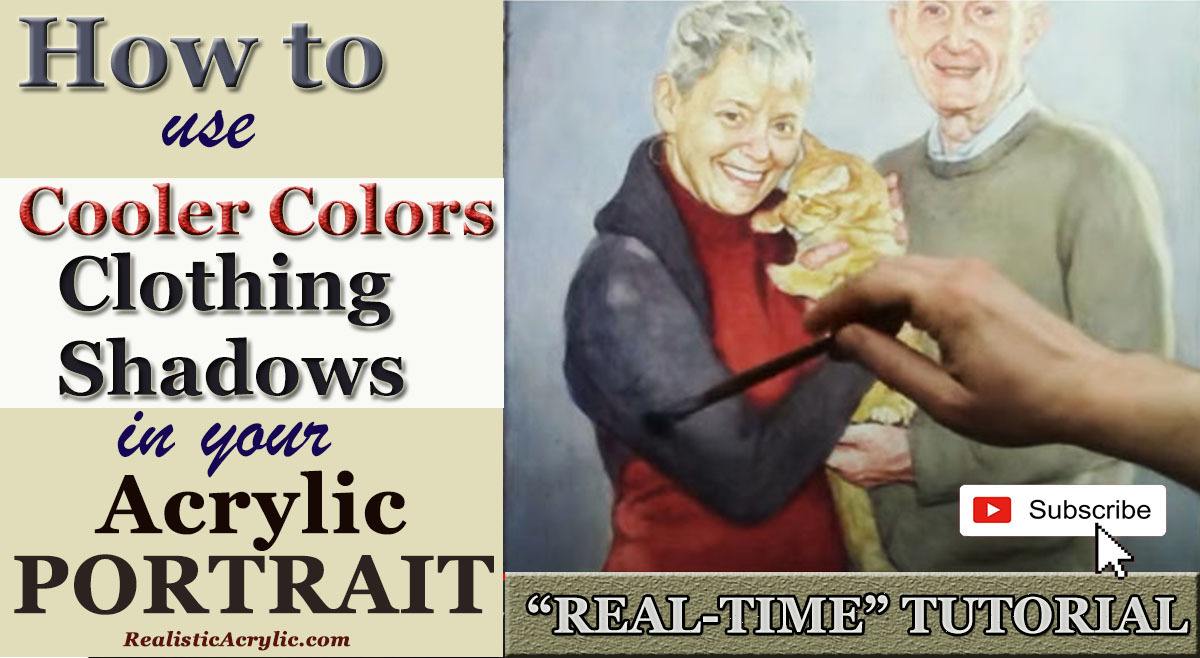
How to Use Cooler Colors for Clothing Shadow
Learning clothing shadows: Cool Color techniques for realism in acrylic portraits
Introduction: Enhancing Realism with Cooler Colors
In acrylic portrait painting, shadows play a pivotal role in creating depth and realism. One technique to elevate your work is using cooler colors for clothing shadow, an approach that may not be immediately obvious. By strategically incorporating cooler tones like blue and gray instead of relying solely on darker shades of the clothing color, you can achieve a subtle and realistic effect. In this tutorial, I’ll walk you through the process of applying cooler colors in clothing shadows using glazing and dry brush techniques to bring your painting to life.
Why Cooler Colors Work for Shadows
The instinct for many artists might be to darken the shadows on clothing with black or a deeper shade of the same color. However, this often leads to overly vibrant or unnatural results. By using cooler tones, such as blue or blue-gray, the shadowed areas can maintain their depth without overpowering the fabric’s natural color.
Key Tip:
When transitioning from light to shadow in your painting, cooler colors help tone down the vibrancy of the clothing while maintaining subtle value shifts.
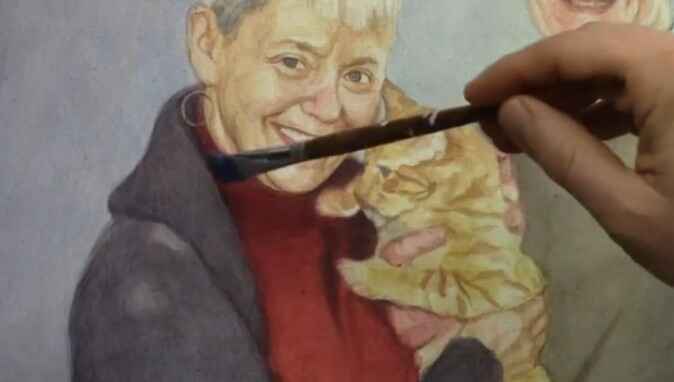
Materials and Colors Used
For this technique, you’ll need a few specific tools and colors:
- Ultramarine Blue: A rich blue tone that works well for creating cooler shadows.
- Raw Umber Dark: A dark brown that adds depth to the blue without overpowering it.
- Matte Medium: A transparent acrylic medium to thin the paint for glazing.
- Flat Brush: Ideal for applying layers of glazes.
- Dry Brush: Perfect for gently feathering in the colors.
By combining these materials, you’ll have the perfect mix to start creating cooler-toned shadows.
Step 1: Mixing the Right Colors
Firstly, is create the right blend of colors for your shadows. Because in the video, I demonstrate how to mix ultramarine blue with raw umber dark. This combination creates a bluish-gray tone that is subtle and cool enough for shadows but still harmonious with the warmer base colors of the clothing.
Process:
- Begin by adding a small amount of ultramarine blue to your palette.
- Mix in a touch of raw umber dark to reduce the brightness of the blue.
- Incorporate matte medium to make the mixture more translucent, ensuring that the shadow layers don’t become too opaque.
This bluish-gray tone will not only darken the shadowed areas but also cool down the intensity, giving the clothing a realistic sense of depth.
Technique Tip:
Always mix small amounts of color first and test it on a separate surface, such as a white card, to see how it interacts with the base layer before applying it to your painting.
Step 2: Applying the Glaze
The glazing is a technique in which the thin layers of translucent paint are applied over dry areas of the painting, then allowing the underlying colors to show through. As a result, it creates a smooth transition from light to shadow without harsh lines.
Process:
- With a flat brush, apply your blue-gray mixture onto the darker areas of the clothing.
- Start by gently glazing the shadowed sections beneath folds, arms, or under the chin.
- Gradually build up the layers, allowing each one to dry before applying the next.
- The glazing process allows you to control the level of darkness and coolness in the shadow while ensuring that the red or other base color remains visible underneath.
Why It Works: The matte medium makes the glaze translucent, so the original clothing color can still be seen through the shadow, adding depth and subtlety to your portrait.
Step 3: Dry Brush Technique for Soft Blending
After applying your glaze, your next step is to use a dry brush technique to softly blend the cooler shadow into the surrounding areas of the clothing. The dry brush technique is particularly effective for adding texture and blending transitions in fabrics.
Process:
- Lightly load your brush with the blue-gray mixture.
- Dab off excess paint on a paper towel to create a dry brush effect.
- Gently stroke the brush over the edges of the shadows, using quick, soft motions to blend the glaze seamlessly into the lighter areas.
- Continue to feather the paint, allowing the cooler shadow to naturally merge with the highlights of the clothing.
Key Tip: The dry brush method allows for smooth transitions without harsh lines, then mimicking the way light softly falls on fabric in real life.
Step 4: Adjusting for Depth and Nuance
As you build the layers and blend your cooler shadows, you may notice that some areas need more depth or subtle variation. Don’t hesitate to adjust your mixture by adding more raw umber dark if the blue becomes too overpowering.
Important Consideration:
Then shadows should appear less vibrant and cooler as they get darker. And then by adjusting the mixture to include more raw umber dark, you can deepen the shadow without making it too cool or overwhelming.
Creating Realistic Clothing Shadows on Multiple Colors
The beauty of this technique is its versatility. You can apply the same blue-gray glaze to multiple fabric colors. For example, in the video, I use it both on the woman’s red clothing and on a man’s shirt. It works just as effectively on lighter-colored fabric, adjusting the tones slightly with each application.
Because by using the same cooler glaze across different fabrics, you create consistency in the shadows, making the portrait appear cohesive and well-integrated.
Conclusion: Mastering Shadows with Cool Tones
When incorporating cooler colors for shadows on clothing in your acrylic portraits allows for greater realism and depth. Because by utilizing a blue-gray glaze and dry brush blending, you can create nuanced shadows that seamlessly integrate with the base color of the fabric. Whether you’re working on bright red clothing or more muted tones, cooler shadows offer the perfect solution for achieving lifelike contrast and depth.
If you’re looking for more instructional videos on how to improve your acrylic painting, visit www.realisticacrylic.com for more tutorials and check out my free courses here. .
- How to Paint Foliage Using the Acrylic Glazing Technique
- How to Trace for an Accurate Portrait Sketch
- How to Paint Realistic Eyes in Your Acrylic Portrait
- How to Add Raw Umber Dark & Ultramarine Blue to Your Portrait
- How to Make Your Own Raw Umber Dark
- How to Paint Realistic Trees & Grass in Your Acrylic
- How to Block In Skin Tone Values Using Glazing Technique
- How to Paint Vibrant Reds in Your Acrylic Portrait
- How to Glaze Background Colors & More Acrylic Portrait
- How to Paint White Clothing in Your Acrylic Portrait
- How to Easily Transition from a Sketch to a Painting
- How to Block In Shading & Skin Tones in Your Acrylic
- How to Build Up Color on Acrylic Pet Portrait
- How to Build Up Form on Clothing with Acrylic
- How to Paint Dark Clothing Using Acrylic Glazing Technique
- How to Paint a 24 x 30 Acrylic With 30 People
- How to Do Smooth Shading with Acrylic
- How to Sketch an Acrylic Portrait with a Grid
Read more about how to paint a portrait that you can surely be proud of!
I’d love to hear your thoughts on this video. Please share it with your friends and family. Let me know if you have any further questions. I’ll greatly help you.
If you’d like to learn more, sign up for my free email tips and video class today.
Learn How to Paint Acrylic Portraits With My Free Mini-Video Course!
Thank you so much for taking the time to read this tutorial and watch the video. That means a lot to me. I hope you find it very helpful in your portrait painting.
Yours for Better Portraits,

P.S. Did you find this post helpful or encouraging? If so, send it on ahead! Let others know with the share buttons below. I’d love to hear your comments. Thank you so much! Also, do you have a question on acrylic portrait painting you’d like answered? Let me know, and I’d be happy to help!
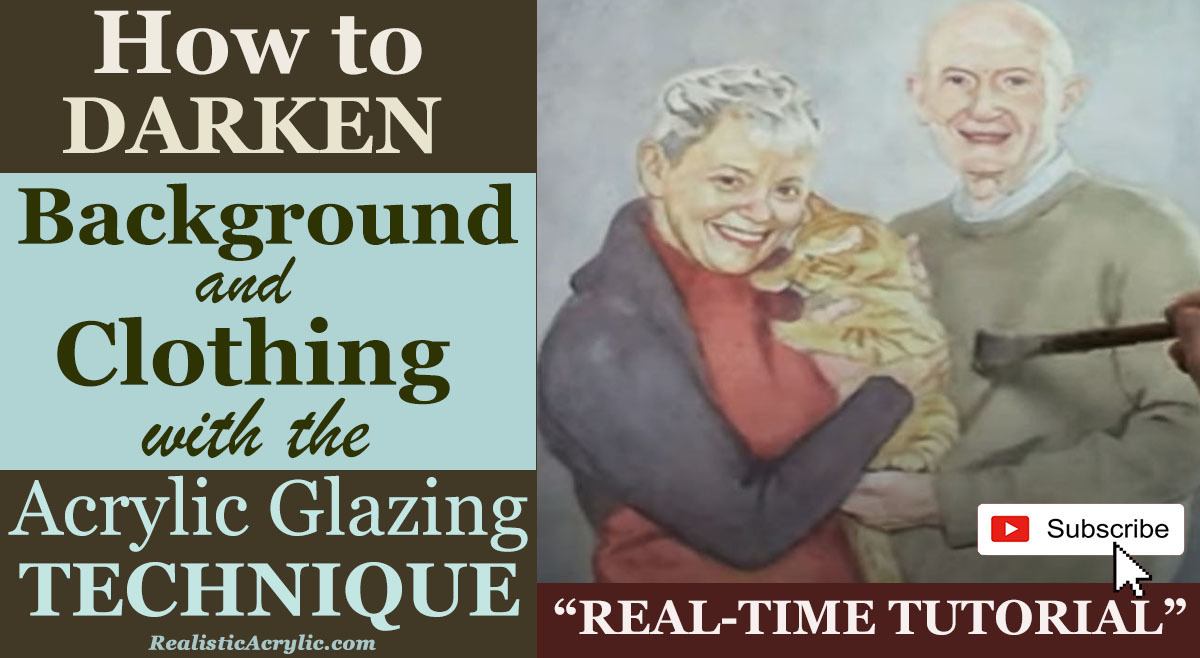
How To Darken Background & Clothing: Acrylic Glazing Technique
Discover the acrylic glazing technique to add depth, richness, and contrast to your portraits by darkening the background and clothing with ease.
One of the challenges portrait artists face is creating a balanced contrast between the subject and the background. Acrylic glazing is an excellent technique for solving this problem, offering the ability to subtly darken elements like the background and clothing while maintaining depth and luminosity. In this tutorial, we’ll explore how to use acrylic glazing to darken the background and clothing in your portraits. Then the key to success in this technique lies in building up light layers of color, allowing the paint to create a rich, oil-like effect that transforms your artwork.
Because at the end of this guide, you’ll be able to create striking contrasts, enhance the mood of your painting, and master acrylic glazing for darker tones.
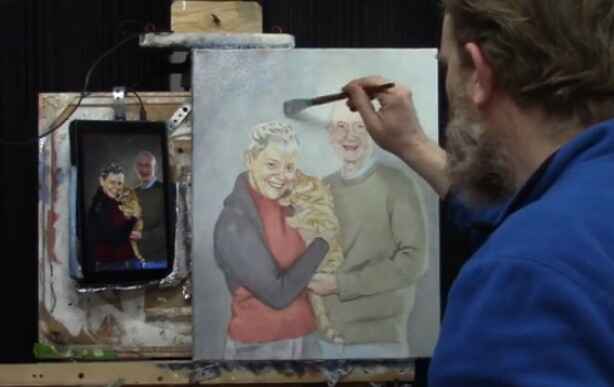
Materials Needed
To achieve the best results with the acrylic glazing technique, you’ll need the following materials:
- Acrylic paints (ultramarine blue, burnt sienna, raw umber, titanium white, etc.)
- Matte medium (or glazing medium)
- Reference photo
- Various brushes (detail brushes, medium flat brush, and large round brush)
- Palette for mixing
- Water and a clean rag
Understanding Acrylic Glazing
Acrylic glazing is a technique where you mix a small amount of pigment with a large amount of matte medium to create thin, transparent layers of color. Each layer allows light to pass through, giving the painting added depth and richness. This technique mimics the effects of oil painting but with the faster drying time of acrylics, making it a versatile choice for many artists.
In this video, we follow the steps to darken the background and clothing of a 16×20 acrylic portrait of a couple and their cat. The key to achieving a smooth glaze is to ensure your base sketch is solid, allowing the layers to enhance rather than correct the painting.
Step 1: Starting with a Solid Sketch
Before applying glazes, it’s essential to have a strong and accurate sketch. As I have mention, that if you want to make sure that the proportions and likeness are perfect before you begin glazing. Because the foundation is key to a successful final product.
When creating your sketch:
- Focus on achieving correct proportions of your subject.
- Make sure the key areas such as the eyes, nose, and mouth are aligned.
- Use light pencil marks that won’t interfere with the transparency of your glaze.
Step 2: Mixing the First Glaze for the Background
In this painting, the client requested a bluish tone for the background. To create a blue glaze, follow these steps:
- Mix Ultramarine Blue: Add a small amount of ultramarine blue to your palette.
- Add Matte Medium: Mix the blue with matte medium until the paint is very translucent. Matte medium is milky white but dries completely clear, allowing the underlying layers to shine through.
- Apply the Glaze: Using short, choppy brush strokes, begin layering the blue glaze onto the background. This creates a smooth transition between the subject and background, enhancing depth.
One of the advantages of glazing is its flexibility. If the glaze looks too intense, you can always add more matte medium or water to lighten it.
Step 3: Building Up Contrast Between the Subject and Background
After applying the initial glaze, focus on enhancing the contrast between the subject (in this case, the couple and their cat) and the background. This step is crucial to making the subject stand out. You want to:
- Gradually increase the opacity of the glazes on the background to push it further into the distance.
- Use darker tones in the background compared to the foreground to create depth.
To darken the background even more, add layers of raw umber or burnt sienna mixed with matte medium on top of the blue glaze. This will give the background a more muted, shadowy effect while still allowing the initial blue tone to shine through.
Step 4: Glazing the Clothing
Next, shift focus to darkening the clothing using a similar glazing technique. The subject in this portrait is wearing darker-toned clothes, and I use the combination of raw umber and ultramarine blue to darken the clothing in a natural, gradual way.
- Mix Raw Umber and Blue: Combine raw umber with ultramarine blue and matte medium. This creates a nice neutral dark glaze that adds depth to the clothing without making it look flat.
- Apply the Glaze: Begin layering this darker glaze on the clothing, focusing on areas of shadow or where more depth is needed.
- Build Layer by Layer: Since glazing is a cumulative process, each layer adds more intensity to the clothing. Don’t worry about getting the perfect color right away. With each layer, the colors will mix and blend, creating a more realistic tone.
Remember, glazing allows you to make adjustments easily. If the color feels too cool or too warm, add a thin glaze of raw sienna or alizarin crimson to adjust the warmth or coolness.
Step 5: Enhancing Details and Finishing Touches
Once the base glazes are in place, use smaller detail brushes to enhance the finer areas, such as the edges of the clothing or folds in the fabric. For example, I use raw sienna to highlight certain areas of the shirt’s wrinkles. Then this subtle addition of color adds a lifelike quality to the painting.
At this stage, pay attention to:
- Wrinkles and folds in the clothing: Use a small brush to carefully apply thin glazes to highlight these details.
- Edge details: Glaze carefully around the edges where the subject meets the background, ensuring a smooth transition.
Tips for Acrylic Glazing Technique
- Use Light Layers: Always apply thin glazes and build up gradually. Heavy applications will obscure the previous layers.
- Dry Between Layers: Allow each glaze to dry before adding the next. This prevents muddying the colors.
- Experiment with Color: Don’t be afraid to adjust the color temperature with warm or cool glazes.
- Less Is More: A little pigment goes a long way when glazing. Be mindful of how much color you mix in with the medium.
- Work from Light to Dark: Build up your painting by working from lighter glazes to darker ones to maintain luminosity and depth.
Conclusion
The acrylic glazing technique offers artists a powerful tool for adding depth and richness to their paintings. When layering transparent color, you can gradually darken backgrounds and clothing without losing the vibrancy of the initial layers. This method also allows for flexibility, as adjustments can be made throughout the process without the pressure of getting it right on the first try.
In this painting of a couple and their cat, the careful use of glazing brings out the contrast between the subjects and their background, creating a compelling portrait. With practice, you’ll be able to master this technique and apply it to your own projects, transforming your portraits into luminous works of art.
If you’re looking for more instructional videos on how to improve your acrylic painting, visit www.realisticacrylic.com for more tutorials and check out my free courses here. .
- Adding highlights to your acrylic painting
- 5 Excellent Reasons to Use Aluminum Foil
- Paint Realistic Wrinkles in Acrylic
- Painting Clothing in an Acrylic Portrait
- Paint a Cloudy Sky Acrylic
- How to add Semi-Opaque Highlights
- How to Enhance the Contrast in Your Acrylic
- How to Add Glaze to Your Acrylic Painting
- Paint Realistic Reflections on Eyeglasses in an Acrylic Portrait
- Build Up Depth on Your Acrylic Portrait Backgrounds
- How Do You Do Layers With the Glazing Technique?
- Learn How to Paint Wrinkles in Acrylic
Read more about how to paint a portrait that you can surely be proud of!
I’d love to hear your thoughts on this video. Please share it with your friends and family. Let me know if you have any further questions. I’ll greatly help you.
If you’d like to learn more, sign up for my free email tips and video class today.
Learn How to Paint Acrylic Portraits With My Free Mini-Video Course!
Thank you so much for taking the time to read this tutorial and watch the video. That means a lot to me. I hope you find it very helpful in your portrait painting.
Yours for Better Portraits,

P.S. Did you find this post helpful or encouraging? If so, send it on ahead! Let others know with the share buttons below. I’d love to hear your comments. Thank you so much! Also, do you have a question on acrylic portrait painting you’d like answered? Let me know, and I’d be happy to help!
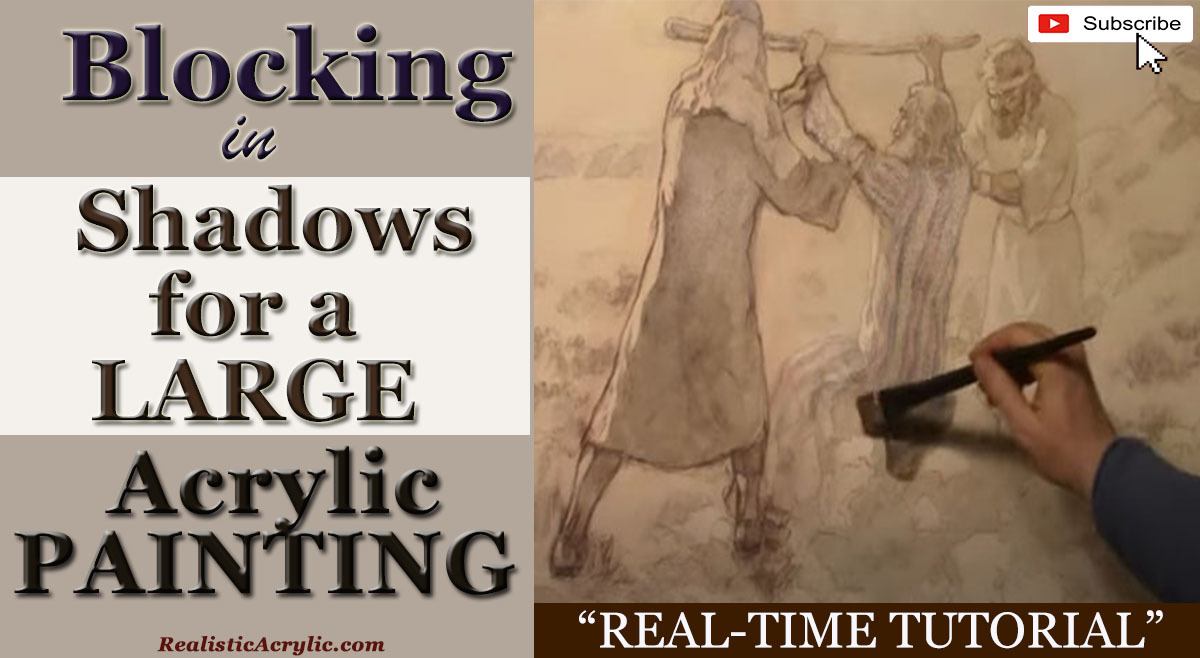
How to Blocking in Shadows for a LARGE Painting
Learn the art of blocking shadows with acrylic glazing for dramatic depth in large paintings
When creating a large acrylic painting, one of the key elements in bringing it to life is mastering the shadow work. Blocking in shadows helps define the structure and form of your subject, adding realism and depth. Using an acrylic glazing technique enhances the shadowing effect, keeping it translucent while still maintaining control over the darker areas of the painting.
In this blog post, we’ll explore a step-by-step approach on how to block in shadows for a large painting. We’ll cover the essential tools, glazing methods, and tips to help you create a more dynamic, realistic piece of art.
Setting the Stage: Preparing for Shadow Blocking
Before diving into the painting process, it’s important to prepare your materials and mindset. I begin this painting session with a moment of reflection and prayer, setting an intention to create a work that captures emotion and depth. Preparation also involves setting up the canvas, sketching the outline of the subject, and sealing the sketch with a light glaze.
For this demonstration, a mixture of raw umber dark and ultramarine blue was chosen for the shadow work. These colors, when blended, create a rich, cool tone that is perfect for shadows. Here’s how you can apply this to your own painting:
- Prepare Your Canvas: Start with a white canvas, sketch your subject, and seal the sketch with a light glaze using diluted acrylic matte medium.
- Choose Your Colors: For shadows, a mix of raw umber dark and ultramarine blue works beautifully to create a cool-toned effect. These colors blend well and offer the right balance between transparency and opacity.
Step-by-Step: Blocking in Shadows
- Creating the First Glaze Layer
Begin by applying a diluted glaze over the areas where shadows will be present. For large paintings, it’s important to keep a wet edge during the application process to avoid streaks or unwanted lines. Using long, sweeping brushstrokes, layer the glaze in areas where you want shadows to appear. - Maintaining Translucency
The beauty of acrylic glazes is their translucent nature. You can still see the sketch beneath the glaze, preserving the fine details as you work on the shadows. To achieve this effect, ensure that your glaze mixture has more medium than pigment, allowing light to pass through. - Building the Tonal Value Structure
Blocking in shadows is more than just applying darker tones. It’s about understanding the value structure of your reference image. In the demonstration, the artist frequently checks his reference photo to ensure that he’s accurately representing the light and shadow interplay. Study your reference carefully and build the shadows from light to dark.- Tip: Cooler tones work well for shadows. Add a small amount of ultramarine blue to your glaze to give the shadows a cooler, more natural effect.
Techniques for Shadow Blocking in Large Paintings
Blocking in shadows for a large painting requires a few specialized techniques. Here are some essential methods to use:
- Layering Glazes for Depth
Rather than applying one thick layer, build your shadows gradually by adding multiple thin layers of glaze. This will help you control the depth and darkness of the shadow, while still maintaining the luminosity of the overall painting. - Vary Your Brush Strokes
As you apply the glaze, it’s helpful to vary the direction of your brushstrokes. This creates a more natural and organic look, especially in areas with fabric or textures like rocks. For example, the artist worked on the figure’s clothing, carefully brushing in the shadows to maintain the folds and creases. - Use a Smaller Brush for Detail
Once the large areas are blocked in, switch to a smaller brush to refine the edges of the shadows. This technique allows you to add subtle details that make the shadowing more realistic.
Key Tips and Techniques for Effective Shadow Work
- Keep a Wet Edge: When applying a glaze, always maintain a wet edge to prevent harsh lines and streaks. This will ensure smooth transitions between the light and shadowed areas.
- Use Cooler Tones: Shadows should be cooler in tone compared to the lighter areas. Adding a hint of ultramarine blue to your glaze helps achieve this effect.
- Layer Glazes for Control: Don’t rush the shadowing process. Build up the intensity gradually by applying thin layers of glaze until you reach the desired depth.
- Pay Attention to Gradation: Shadows are rarely uniform in tone. They often fade or blend into lighter areas. Adjust your glaze to create smooth gradations between light and dark.
Applying Glazes to Specific Elements
In the video, I focused on several parts of the painting and then demonstrated the blocking in of shadows:
- The Figure’s Clothing: By using a combination of raw umber dark and ultramarine blue, the artist darkened the folds of the figure’s clothing, preserving the highlights and lighter areas.
- The Rocks: Shadows were added to the rocks behind the main figures, using a slightly bolder application of glaze. The cooler tones gave the rocks a natural shadowed effect, which contrasted well with the lighter areas.
- Background Elements: Blocking in shadows for the background elements, such as the sky and distant stones, helps create a sense of depth and distance. In this case, the artist allowed the shadows to blend naturally into the lighter tones, creating a balanced contrast.
Finishing Touches: Refining the Shadows
Once the shadow areas are blocked in, the final step involves refining the details. Then I used a smaller brush to control the finer aspects of the shadows, ensuring that they didn’t overpower the highlights. This delicate balance between light and shadow is what ultimately brings the painting to life.
- Pro Tip: If a glaze feels too bold, you can always lighten it by gently brushing over the area with a bit of water or clear medium to soften the edges.
Conclusion: Mastering the Art of Shadow Blocking
Blocking in shadows is a crucial skill for any artist, especially when working on large paintings. By using acrylic glazing techniques, you can add depth and realism while preserving the underlying details. Remember to take your time, build the shadows in layers, and constantly refer to your reference photo to ensure accuracy.
Master this technique, and you’ll find your large acrylic paintings gaining new levels of dimension and realism.
If you’re looking for more instructional videos on how to improve your acrylic painting, visit www.realisticacrylic.com for more tutorials and check out my free courses here. .
- Adding highlights to your acrylic painting
- 5 Excellent Reasons to Use Aluminum Foil
- Paint Realistic Wrinkles in Acrylic
- Painting Clothing in an Acrylic Portrait
- Paint a Cloudy Sky Acrylic
- How to add Semi-Opaque Highlights
- How to Enhance the Contrast in Your Acrylic
- How to Add Glaze to Your Acrylic Painting
- Paint Realistic Reflections on Eyeglasses in an Acrylic Portrait
- Build Up Depth on Your Acrylic Portrait Backgrounds
- How Do You Do Layers With the Glazing Technique?
- Learn How to Paint Wrinkles in Acrylic
Read more about how to paint a portrait that you can surely be proud of!
I’d love to hear your thoughts on this video. Please share it with your friends and family. Let me know if you have any further questions. I’ll greatly help you.
If you’d like to learn more, sign up for my free email tips and video class today.
Learn How to Paint Acrylic Portraits With My Free Mini-Video Course!
Thank you so much for taking the time to read this tutorial and watch the video. That means a lot to me. I hope you find it very helpful in your portrait painting.
Yours for Better Portraits,

P.S. Did you find this post helpful or encouraging? If so, send it on ahead! Let others know with the share buttons below. I’d love to hear your comments. Thank you so much! Also, do you have a question on acrylic portrait painting you’d like answered? Let me know, and I’d be happy to help!
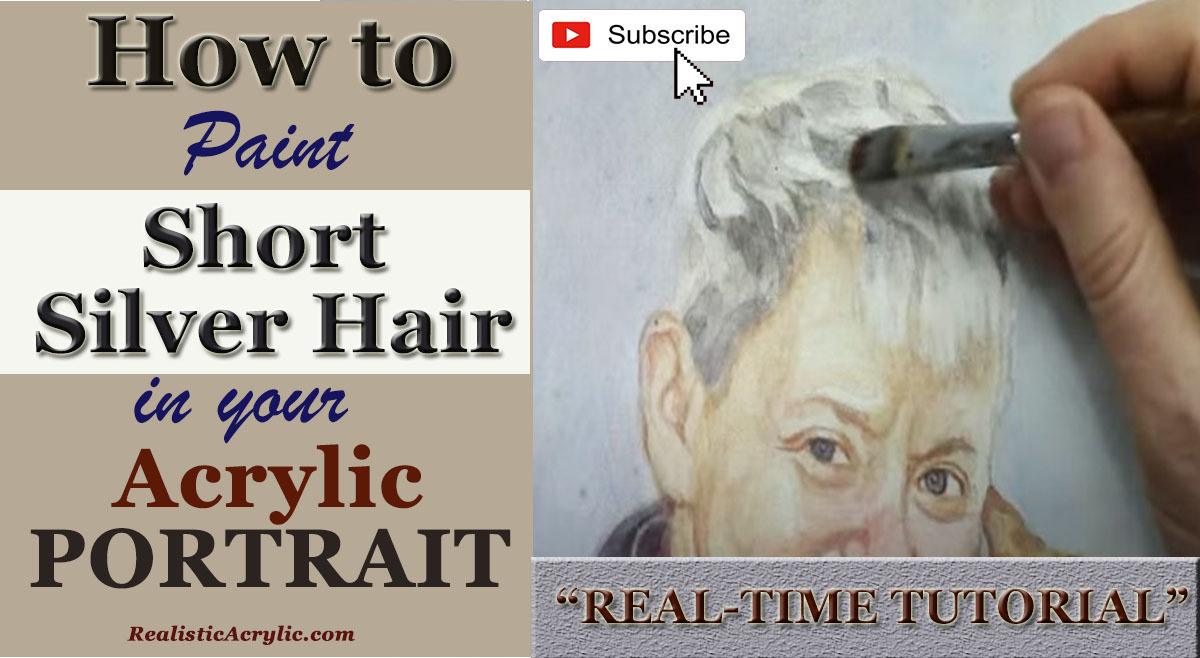
How to Paint Short Silver Hair in your Acrylic
Discover the secrets to painting realistic short silver hair using the acrylic glazing technique for depth, vibrance, and seamless blending.
Painting realistic short silver hair in acrylic can seem challenging, but with the right techniques, it becomes manageable and rewarding. In this tutorial, I will guide you step-by-step on how to apply the acrylic glazing technique to capture the softness, shine, and texture of silver hair. Whether you’re a beginner or an experienced artist, mastering this technique will help you create stunning portraits with depth and vibrance. We will focus on blending shades, adding highlights, and building subtle nuances for a natural-looking effect.
Understanding Acrylic Glazing for Hair
Acrylic glazing is an essential technique for adding layers of semi-transparent color over your base. By layering different shades, you can achieve depth and a lifelike sheen, perfect for capturing the essence of silver hair. Instead of trying to nail every detail in one go, glazing allows you to build the portrait gradually, adding complexity with each new layer.
Tips for Acrylic Glazing:
- Use a mix of acrylic matte medium with your paint to create a smooth, translucent layer.
- Work with a soft, fine brush to ensure smooth transitions between shades.
- Build layers slowly, allowing each one to dry before adding the next for better control over color depth.
Choosing Your Color Palette
When painting short silver hair, selecting the right color palette is essential. Although silver is often seen as a neutral tone, it actually contains a mixture of hues such as cool blues, grays, and even some warmer tones to reflect light.
For this tutorial, the palette includes:
- Titanium White: For bright highlights and reflective areas.
- Burnt Umber: To add warmth and contrast in the shadows.
- Raw Umber: For mid-tones and foundational shading.
- Ultramarine Blue: Helps cool down areas and enhance the silver effect.
- Alizarine Crimson: Adds subtle warmth and depth.
Tip: Always test your color combinations on a palette before applying them to the canvas. Mix small amounts to see how they interact under different lighting conditions.
Step-by-Step Guide to Painting Short Silver Hair
1. Start with the Underpainting
Before you apply any details, establish a base using a neutral underpainting. This is where you define the overall shapes and contours of the hair. For silver hair, use a mix of raw umber and titanium white to sketch out the general flow and placement of the hair strands. Remember to think of hair not as individual strands but as groups of shapes and shadows.
Technique Tip: Use a soft filbert brush to apply the underpainting in smooth, broad strokes. This will help create a soft foundation for the subsequent layers.
2. Building Mid-Tones with Glazing
Once the underpainting is dry, begin adding mid-tones using the acrylic glazing technique. Mix ultramarine blue and burnt umber with a small amount of matte medium to create a semi-transparent glaze. This mixture will give your hair a cool, metallic feel. Apply the glaze over the darker areas, building the transition from shadow to light.
Technique Tip: Apply the glaze in thin layers, allowing each coat to dry before adding another. This will help create depth and prevent the colors from becoming too muddy or opaque.
3. Adding Highlights
Silver hair catches light in unique ways, often appearing more reflective than other hair colors. To capture this, mix titanium white with a tiny bit of raw umber and alizarine crimson. Use this mixture to gently highlight the areas where the light naturally hits the hair, such as the crown of the head and the edges of the strands.
Tip: Use a small round brush for highlights to add fine, delicate lines. Blend the edges of the highlights into the mid-tones to avoid harsh transitions.
4. Deepening the Shadows
Shadows in silver hair help give it volume and shape. For this, mix a slightly darker glaze with more burnt umber and ultramarine blue. Focus on the areas where the hair overlaps or falls into deeper recesses, such as around the ears or where the hair gathers near the scalp.
Technique Tip: When applying shadows, think of the hair in terms of mass rather than individual strands. Keep the shapes soft and avoid over-defining every strand to maintain a natural look.
5. Refining the Details
As you continue building up the layers of glazes, the hair will start to take on a more realistic appearance. At this stage, focus on refining small details, such as the subtle shifts in tone and light across the hair. Add final touches by applying thin, semi-transparent layers of titanium white mixed with matte medium for the brightest highlights.
Tip: Don’t overwork the painting. Let some of the earlier layers show through to enhance the depth and complexity of the hair.
Common Mistakes to Avoid
- Overloading the Brush: Avoid applying too much paint at once. This can make your glaze too thick and result in harsh lines instead of smooth transitions.
- Skipping the Drying Time: Acrylic paint dries fast, but it’s important to let each layer fully dry before applying the next. Rushing this process can lead to muddy colors and a lack of definition.
- Neglecting the Highlights: For silver hair, highlights are crucial. Make sure to spend enough time building up the light areas to capture the reflective quality of the hair.
Final Thoughts
Painting short silver hair in acrylic requires patience and a careful approach, but the results are worth the effort. By using the glazing technique, you can achieve depth, softness, and shine that will make the hair in your portrait come to life. Whether you’re painting a portrait of a loved one or a professional commission, these techniques will help you capture the unique beauty of silver hair with confidence.
Remember, as with all acrylic painting techniques, practice makes perfect. So, don’t be afraid to experiment with different glazes, brushes, and colors to find what works best for you.
Conclusion
When mastering the art of painting short silver hair is a valuable skill for any portrait artist. With then the right use of acrylic glazing, attention to color blending, and proper brush techniques, you can create stunning, realistic results. By following these steps and tips, you will develop the confidence to tackle even the most challenging portrait hair details.
Keep practicing, and soon, painting silver hair will become second nature!
If you’re looking for more instructional videos on how to improve your acrylic painting, visit www.realisticacrylic.com for more tutorials and check out my free courses here. .
- How to Paint Foliage Using the Acrylic Glazing Technique
- How to Trace for an Accurate Portrait Sketch
- How to Paint Realistic Eyes in Your Acrylic Portrait
- How to Add Raw Umber Dark & Ultramarine Blue to Your Portrait
- How to Make Your Own Raw Umber Dark
- How to Paint Realistic Trees & Grass in Your Acrylic
- How to Block In Skin Tone Values Using Glazing Technique
- How to Paint Vibrant Reds in Your Acrylic Portrait
- How to Glaze Background Colors & More Acrylic Portrait
- How to Paint White Clothing in Your Acrylic Portrait
- How to Easily Transition from a Sketch to a Painting
- How to Block In Shading & Skin Tones in Your Acrylic
- How to Build Up Color on Acrylic Pet Portrait
- How to Build Up Form on Clothing with Acrylic
- How to Paint Dark Clothing Using Acrylic Glazing Technique
- How to Paint a 24 x 30 Acrylic With 30 People
- How to Do Smooth Shading with Acrylic
- How to Sketch an Acrylic Portrait with a Grid
Read more about how to paint a portrait that you can surely be proud of!
I’d love to hear your thoughts on this video. Please share it with your friends and family. Let me know if you have any further questions. I’ll greatly help you.
If you’d like to learn more, sign up for my free email tips and video class today.
Learn How to Paint Acrylic Portraits With My Free Mini-Video Course!
Thank you so much for taking the time to read this tutorial and watch the video. That means a lot to me. I hope you find it very helpful in your portrait painting.
Yours for Better Portraits,

P.S. Did you find this post helpful or encouraging? If so, send it on ahead! Let others know with the share buttons below. I’d love to hear your comments. Thank you so much! Also, do you have a question on acrylic portrait painting you’d like answered? Let me know, and I’d be happy to help!
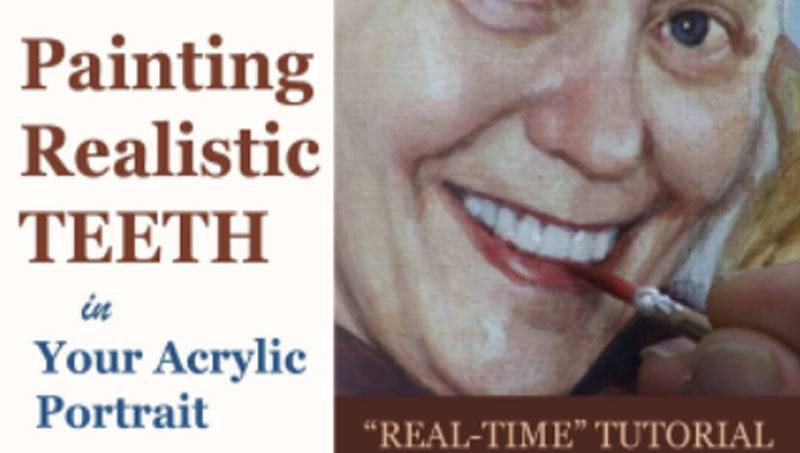
How to Refine the Shape of Teeth in Your Acrylic Portrait
Master the subtle art of refining teeth in your acrylic portraits for greater accuracy and lifelike results.
Introduction: Why Refining Teeth Matters in Portraiture
When capturing the likeness of a subject in portraiture can hinge on seemingly minor details. One such detail is the refinement of teeth. It may seem small, but accurately painting teeth, especially the bottom ridges, plays a critical role in rendering a realistic, lifelike portrait. Subtle nuances in the shape of the teeth can dramatically alter the facial expression and overall appearance of the subject.
In this tutorial, you will learn how to refine the shape of teeth using acrylics. We’ll focus on the process of painting the subtle bumps on the bottom of the teeth, ensuring that your portraits achieve a more polished and authentic result.
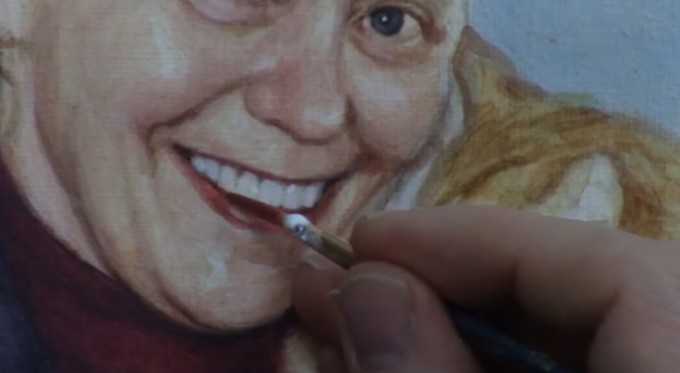
Step 1: Analyzing the Reference Photo
Before picking up your brush, it’s important to thoroughly examine your reference photo. The shape and position of the teeth vary significantly from person to person, and replicating these unique traits is key to capturing the subject’s likeness.
Tip: Zoom in on your reference photo to observe the details of the teeth, especially the bottom edge where subtle bumps and curves may appear. This is where the separation between the teeth and the gums becomes more pronounced.
Technique: Keep the focus on how the light hits the edges of the teeth and gums, as this will guide you in applying shadows and highlights.
Step 2: Mixing the Right Colors
In this next phase, you’ll begin by mixing a base color that is slightly darker than the lip color to define the bottom edge of the teeth. To create this mix, combine the following colors:
- Pyrolle Orange (also known as Organic Orange)
- Alizarine Crimson
- A small amount of Raw Umber Dark
These colors produce a rich, reddish hue that closely matches the natural coloration around the teeth and lips. If needed, adjust the mix by adding a touch of titanium white to lighten the color without losing its vibrancy.
Tip: Use a white card to test your color before applying it to the painting. This will allow you to see how it contrasts with your existing skin tones and lips.
Technique: Apply the color in thin layers, pulling up toward the gums to create the natural transitions between the teeth, gums, and lip area. It’s important to paint with precision to avoid making the teeth appear too long.
Step 3: Adding Subtle Details
To refine the teeth further, you’ll need to add delicate shadows and highlights. Start by mixing a darker color for the shadows:
- Ultramarine Blue
- Alizarine Crimson
- A bit of Raw Umber Dark
This creates a deeper, more muted tone that will help add definition to the bottom of each tooth. You can use this color to subtly separate the teeth from one another.
Tip: Avoid making the lines between the teeth too dark or harsh. The goal is to create a natural look, not to outline each tooth dramatically. A soft, gradual transition between light and dark will ensure that the teeth appear realistic.
Technique: Apply this darker shade right below the teeth, particularly where the bottom row meets the gums. Remember, each tooth has slight variations in shading, so pay attention to your reference photo to determine where the shadows fall.
Step 4: Softening Edges for Realism
Once the main colors and shadows have been applied, it’s time to refine the edges of the teeth. You can soften the hard edges by blending the colors gently where the teeth meet the gums and where the light hits the teeth.
Mix a small amount of titanium white with raw umber dark to create a subtle highlight color. Apply this along the top of the teeth where light would naturally reflect off the enamel.
Tip: Don’t overdo the highlights. The key is to add just enough light to define the shape of the teeth without making them look too bright or artificial.
Technique: Lightly brush over the teeth with small, upward strokes. This will give the teeth a more rounded, natural appearance and help avoid a “flat” look.
Step 5: Fine-Tuning the Details
Now that the main shapes and shadows are in place, it’s time to fine-tune the details. Look at the spaces between the teeth and make any necessary adjustments to ensure they aren’t too close together or too far apart. Add any final touches of shadow or highlight that might be missing.
Tip: Step back from your painting occasionally to check how the teeth fit into the overall portrait. Sometimes, it’s easier to notice small errors or imbalances when viewing the piece from a distance.
Technique: Use a small, fine-tipped brush to add the final strokes of detail. These small refinements make a significant difference in the realism of the portrait.
Why This Process Matters
Refining the shape of teeth is one of those small but crucial steps in portrait painting. When done right, it adds to the likeness of the subject and creates a more lifelike portrait. If the teeth are too bright, too long, or inaccurately shaped, it can detract from the overall piece.
By using the techniques outlined above carefully mixing colors, softening edges, and adding subtle highlights and shadows you will ensure that your acrylic portrait looks polished and professional.
Conclusion: Elevate Your Portrait with Refined Details
As you can see, refining the shape of teeth in an acrylic portrait isn’t about painting them with strict lines and bright colors. Instead, it’s about creating soft transitions between light and shadow, observing your reference closely, and painting with patience.
With these techniques, your portraits will capture the likeness and subtle beauty of your subjects, ensuring that every detail, no matter how small, contributes to the overall realism.
If you found this guide helpful, be sure to explore more tutorials on realisticacrylic.com. Whether you’re just starting or looking to refine your skills further, you’ll find valuable resources to help you paint portraits you can be proud of.
Final Tips for Refining Teeth in Acrylic Portraits
- Use small, precise brushes for the detailed work around the teeth and gums.
- Layer your colors rather than applying too much paint at once. Thin layers create depth.
- Test your colors on a white card to ensure they blend naturally with surrounding skin tones.
- Soften hard edges to avoid a flat, unrealistic look.
- Check your reference photo frequently to ensure you’re capturing the unique shape and characteristics of your subject’s teeth.
For further resources and guides, visit realisticacrylic.com and check out my free courses to enhance your acrylic painting journey.
- How to Paint Foliage Using the Acrylic Glazing Technique
- How to Trace for an Accurate Portrait Sketch
- How to Paint Realistic Eyes in Your Acrylic Portrait
- How to Add Raw Umber Dark & Ultramarine Blue to Your Portrait
- How to Make Your Own Raw Umber Dark
- How to Paint Realistic Trees & Grass in Your Acrylic
- How to Block In Skin Tone Values Using Glazing Technique
- How to Paint Vibrant Reds in Your Acrylic Portrait
- How to Glaze Background Colors & More Acrylic Portrait
- How to Paint White Clothing in Your Acrylic Portrait
- How to Easily Transition from a Sketch to a Painting
- How to Block In Shading & Skin Tones in Your Acrylic
- How to Build Up Color on Acrylic Pet Portrait
- How to Build Up Form on Clothing with Acrylic
- How to Paint Dark Clothing Using Acrylic Glazing Technique
- How to Paint a 24 x 30 Acrylic With 30 People
- How to Do Smooth Shading with Acrylic
- How to Sketch an Acrylic Portrait with a Grid
Read more about how to paint a portrait that you can surely be proud of!
I’d love to hear your thoughts on this video. Please share it with your friends and family. Let me know if you have any further questions. I’ll greatly help you.
If you’d like to learn more, sign up for my free email tips and video class today.
Learn How to Paint Acrylic Portraits With My Free Mini-Video Course!
Thank you so much for taking the time to read this tutorial and watch the video. That means a lot to me. I hope you find it very helpful in your portrait painting.
Yours for Better Portraits,

P.S. Did you find this post helpful or encouraging? If so, send it on ahead! Let others know with the share buttons below. I’d love to hear your comments. Thank you so much! Also, do you have a question on acrylic portrait painting you’d like answered? Let me know, and I’d be happy to help!
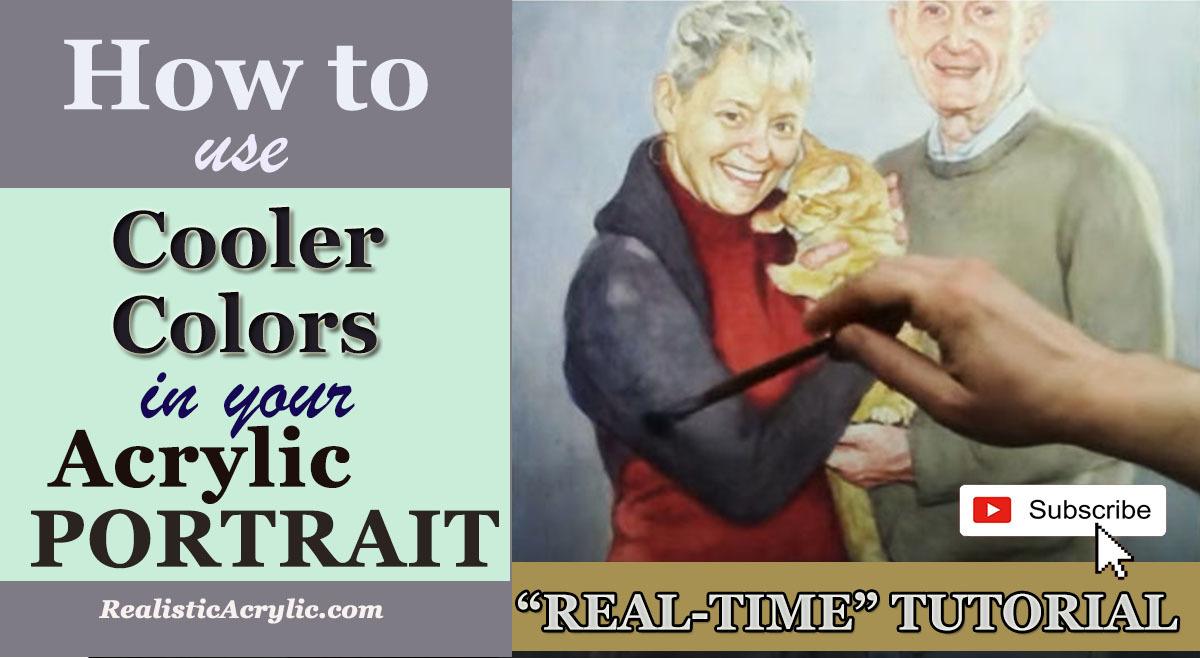
How to Use Cooler Colors in Your Acrylic Portrait
Learn the art of using cooler tones for shadows and contrast to bring depth and realism to your acrylic portrait painting
Introduction
In acrylic portrait painting, the choice of colors can dramatically impact the realism of your artwork. One technique that often gets overlooked is the use of cooler colors, particularly for creating shadows and depth. Instead of relying on darker versions of the same color or black, incorporating cooler hues like blue and gray can bring out more natural and nuanced details in your portraits. In this tutorial, we will explore how to use cooler colors, specifically in shadows and darker areas, to enhance the depth and contrast of your acrylic portraits.
The Role of Cooler Colors in Acrylic Portraits
Cooler colors, such as blues and grays, are ideal for creating subtle and realistic shadows in portrait painting. Because by using cooler tones in shadowed areas, you avoid overly vibrant or muddy colors that can flatten the subject. Cooler shades also help control the brightness in darker values without overpowering the other tones in your painting. Then shadows should never be too warm, as they might disrupt the balance of the painting. Instead, by adding cooler hues, you’ll create a sense of depth and dimensionality that feels natural.

Why Not Use Black?
It’s tempting to use black or simply darker shades of your base color for shadows. However, this approach often makes shadows look too harsh or unnatural. Instead, combining cooler colors like ultramarine blue mixed with brown tones, such as raw umber, produces a more harmonious, darker value. This method lets you keep the integrity of your portrait’s vibrancy while still defining areas of shade.
Techniques for Using Cooler Colors
1. The Glazing Technique
Glazing is a technique where thin, translucent layers of paint are applied over an existing layer to adjust the hue and value without covering the underlying color completely. In this video, we use ultramarine blue mixed with raw umber dark and matte medium to create a translucent shadow that gently cools the red clothing in the portrait.
- Materials Needed:
- Ultramarine blue
- Raw umber dark
- Matte medium
By using this combination, you get a subtle cooler tone that darkens the red areas without losing the warmth of the original color. The matte medium ensures that the paint layer remains translucent, allowing the original red to shine through but with a softened, shadowed effect. This technique works well for shading clothing, hair, and other elements in a portrait where subtle shadows enhance realism.
2. Dry Brush Technique for Fine Shading
The dry brush technique, as shown in the video, allows for fine-tuning of cooler colors in areas where you want to add texture or smooth gradients. By lightly dragging the nearly dry brush over the surface, you can blend colors gently and gradually. This is particularly effective for textured clothing or rough surfaces where you need shadows to add realism without overpowering the light source.
- Steps to Achieve the Effect:
- Dip your brush in the paint mixture and then wipe off most of it, leaving only a trace amount on the bristles.
- Lightly brush over the desired area, letting the minimal paint layer gradually blend in.
- Continue adding more layers as needed, allowing the painting to build up gradually.
The dry brush technique works best for elements like clothing or textured surfaces in your portrait, where there’s room for a more natural, rough finish. It adds depth without losing the existing colors underneath.
3. Layering Cool Tones
When you apply cooler tones, especially when using the glazing technique, you can layer them to achieve depth. In the video, I use the bluish-gray color not only on the red sweater but also on the surrounding darker areas of the portrait. By layering these cooler tones, you can transition between shadows smoothly, unifying the portrait without jarring contrasts. Each glaze or layer adds a subtle gradation, which makes the painting feel more cohesive.
Where to Use Cooler Colors in a Portrait
- Shadows Under the Chin:
Cooler colors like ultramarine blue mixed with raw umber create a natural shadow under the chin without overpowering the light source. The coolness of the blue offsets the warmth of skin tones, providing a balanced and realistic shadow. - Clothing Shadows:
As demonstrated in the video, applying a cooler glaze to the darker parts of clothing can reduce the vibrancy of warm colors while preserving their richness. This keeps the fabric from looking too harsh or over-saturated in shadowed areas. - Hair and Other Textured Areas:
The dry brush technique works particularly well in areas where texture is important, such as hair. By using cooler tones and a dry brush method, you can add subtle highlights and shadows to hair, enhancing its dimensionality.
Benefits of Using Cooler Colors
- Increased Depth and Dimension:
Cooler colors, particularly in shadows, add depth and realism to a portrait. They allow shadows to recede into the background while keeping the subject looking three-dimensional. - More Natural Shadows:
Rather than simply darkening a color with black or gray, using cooler tones helps create more natural shadows. This results in smoother transitions between light and dark areas. - Control Over Vibrancy:
Cooler tones help reduce the intensity of vibrant colors, especially in shadowed areas, giving your painting a more balanced and professional look.
Tips for Success
- Experiment with Ratios:
The ratio of ultramarine blue to raw umber can be adjusted depending on the desired level of coolness in your shadows. For darker areas, use more blue and less umber to deepen the shadow. - Build in Layers:
Always work in layers when using cooler colors. Apply a thin glaze, let it dry, and then build up the color gradually. This prevents the painting from becoming too dark or muddy. - Use Matte Medium:
Matte medium helps maintain the translucency of your paint layers, allowing you to adjust the color and value without losing the underlying colors. It’s crucial when applying cool tones, especially over warm areas.
Conclusion
Using cooler colors in your acrylic portrait can make all the difference when it comes to creating realistic shadows, depth, and contrast. Techniques like glazing and dry brushing with cooler tones such as ultramarine blue and raw umber dark allow you to darken areas without compromising the vibrancy and balance of your painting. If you’re looking to improve your portrait painting skills, remember that shadows are just as important as highlights—and cooler tones are your secret weapon for mastering them.
For more tutorials on acrylic painting techniques, check out realisticacrylic.com, where you can access free tips, tutorials, and classes to enhance your artistic journey.
- Adding highlights to your acrylic painting
- 5 Excellent Reasons to Use Aluminum Foil
- Paint Realistic Wrinkles in Acrylic
- Painting Clothing in an Acrylic Portrait
- Paint a Cloudy Sky Acrylic
- How to add Semi-Opaque Highlights
- How to Enhance the Contrast in Your Acrylic
- How to Add Glaze to Your Acrylic Painting
- Paint Realistic Reflections on Eyeglasses in an Acrylic Portrait
- Build Up Depth on Your Acrylic Portrait Backgrounds
- How Do You Do Layers With the Glazing Technique?
- Learn How to Paint Wrinkles in Acrylic
Read more about how to paint a portrait that you can surely be proud of!
I’d love to hear your thoughts on this video. Please share it with your friends and family. Let me know if you have any further questions. I’ll greatly help you.
If you’d like to learn more, sign up for my free email tips and video class today.
Learn How to Paint Acrylic Portraits With My Free Mini-Video Course!
Thank you so much for taking the time to read this tutorial and watch the video. That means a lot to me. I hope you find it very helpful in your portrait painting.
Yours for Better Portraits,

P.S. Did you find this post helpful or encouraging? If so, send it on ahead! Let others know with the share buttons below. I’d love to hear your comments. Thank you so much! Also, do you have a question on acrylic portrait painting you’d like answered? Let me know, and I’d be happy to help!
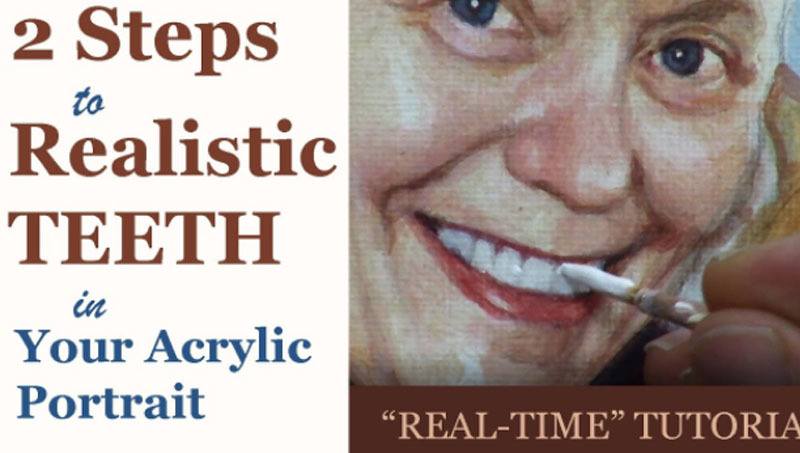
2 Steps on How to Make Teeth More Realistic
Learn how to add realistic depth and dimension to teeth in your acrylic portraits using these simple but effective techniques.
When painting an acrylic portrait, one of the areas that often challenges artists is getting the teeth to look realistic. Many artists fall into the common trap of painting teeth flat white, which detracts from the lifelike quality of a portrait. Teeth, however, are far from being a pure white color. In this guide, you’ll learn two simple yet effective steps that will elevate your skills in painting teeth, making them appear more realistic and natural.
Step 1: Proper Shading – Teeth Are Not White
One of the most frequent mistakes made when painting teeth is assuming they are stark white. In reality, teeth are often a light shade of gray or slightly off-white. In fact, if you compare teeth to a pure white object, you’ll notice they are significantly darker. Painting teeth flat white can give your portrait an artificial look and flatten the depth of the face.
To ensure you are capturing the right tone, use a white card to measure the value of your teeth compared to the background of your reference photo. When you observe closely, you’ll find that teeth have more of a grayish hue. By painting the teeth just a little darker than pure white, you create a realistic foundation that allows you to build up detail.
Here’s how you can achieve this:
- Mix titanium white with a small amount of raw umber dark and ultramarine blue to create a subtle grayish hue. This will be your base color for shading the teeth.
- Apply thin layers, blending the paint carefully, to ensure a smooth transition. The blend should not be too dark, but noticeably darker than pure white.
- To add more depth, mix a bit of matte medium into the paint. Matte medium helps thin the acrylic paint without compromising its color, allowing you to create soft, seamless shading that brings out the three-dimensional quality of the teeth.
By following these steps, you are creating the necessary contrast between the teeth and the bright highlights that will come in the next step.
Tip: Focus on the Surrounding Shadows
Shadows play an important role in shaping the teeth. Gums and lips often cast subtle shadows over teeth, making the edges slightly darker. Pay attention to these areas, especially around the perimeter of the teeth, to enhance the sense of depth. Remember, teeth are curved objects; shading on one side, while leaving the other lighter, will make them appear more dimensional.
Step 2: Adding Realistic Highlights – Bring the Teeth to Life
Once you’ve laid down the correct base color for the teeth, the next step is to add realistic highlights. These highlights are small but essential details that bring the teeth to life and make them look natural.
Teeth often have tiny reflections of light in certain areas, depending on the lighting in your reference photo. These highlights can be found along the tops of the teeth or on the edges where they catch the light the most. Here’s how you can effectively apply them:
- Use titanium white for these highlights. Unlike the shading, the highlights should be pure white, but use them sparingly to avoid an unnatural appearance.
- With a size 2 liner brush, carefully paint small pinpoint highlights in the appropriate spots, as seen in your reference image. The upper teeth often have highlights near the top, close to where the lips meet the teeth.
- After applying the highlights, blend them gently into the surrounding areas to avoid hard, distracting lines. The goal is to create a soft transition between the shaded and highlighted areas.
If the highlights appear too stark, you can modify the tone by adding a touch of indian yellow to warm them up. By warming the highlights, you mimic the natural hue of teeth, which tend to reflect a warmer tone due to their interaction with light and surrounding skin tones.
Tip: Be Subtle with Separation Lines
While teeth have visible separation lines, especially in close-up portraits, these lines should not be harsh. Use very faint lines to delineate individual teeth. A common mistake is making the lines too bold, which can give the teeth an outlined, cartoonish appearance. The size 2 liner brush is ideal for lightly sketching in these lines, but ensure they are soft enough to blend in with the rest of the portrait.
Additional Techniques to Improve Realism
1. Use Glazing for Depth
To create even more depth and nuance in the teeth, consider using a glazing technique. A glaze is a thin, translucent layer of paint that allows underlying layers to show through, creating a sense of depth.
- Mix a small amount of matte medium with your base gray color and apply it lightly over the teeth, focusing on areas that need more depth, such as the sides or lower parts of each tooth.
- This glazing technique allows you to build up subtle layers, increasing the realistic appearance of your portrait.
2. Pay Attention to Tooth Shape and Size
Not all teeth are the same size or shape, and these variations should be reflected in your painting. The front teeth are typically larger, while the ones on the sides taper off. Make sure to study your reference photo closely and adjust the size and shape of each tooth accordingly. This attention to detail will make your portrait look more realistic and proportional.
Conclusion
Getting the teeth right in an acrylic portrait is an essential step toward achieving realism. By shading the teeth a few tones darker than pure white and adding subtle highlights in the right spots, you can dramatically improve the lifelike quality of your portraits. Using techniques like glazing and paying attention to tooth shape will further enhance the overall effect. Follow these two steps carefully, and you’ll be well on your way to mastering the art of painting realistic teeth in acrylics.
With patience and practice, you’ll see improvements in your portrait painting skills, and your work will stand out for its lifelike qualities.
For further resources and guides, visit realisticacrylic.com and check out my free courses to enhance your acrylic painting journey.
- Adding highlights to your acrylic painting
- 5 Excellent Reasons to Use Aluminum Foil
- Paint Realistic Wrinkles in Acrylic
- Painting Clothing in an Acrylic Portrait
- Paint a Cloudy Sky Acrylic
- How to add Semi-Opaque Highlights
- How to Enhance the Contrast in Your Acrylic
- How to Add Glaze to Your Acrylic Painting
- Paint Realistic Reflections on Eyeglasses in an Acrylic Portrait
- Build Up Depth on Your Acrylic Portrait Backgrounds
- How Do You Do Layers With the Glazing Technique?
- Learn How to Paint Wrinkles in Acrylic
Read more about how to paint a portrait that you can surely be proud of!
I’d love to hear your thoughts on this video. Please share it with your friends and family. Let me know if you have any further questions. I’ll greatly help you.
If you’d like to learn more, sign up for my free email tips and video class today.
Learn How to Paint Acrylic Portraits With My Free Mini-Video Course!
Thank you so much for taking the time to read this tutorial and watch the video. That means a lot to me. I hope you find it very helpful in your portrait painting.
Yours for Better Portraits,

P.S. Did you find this post helpful or encouraging? If so, send it on ahead! Let others know with the share buttons below. I’d love to hear your comments. Thank you so much! Also, do you have a question on acrylic portrait painting you’d like answered? Let me know, and I’d be happy to help!
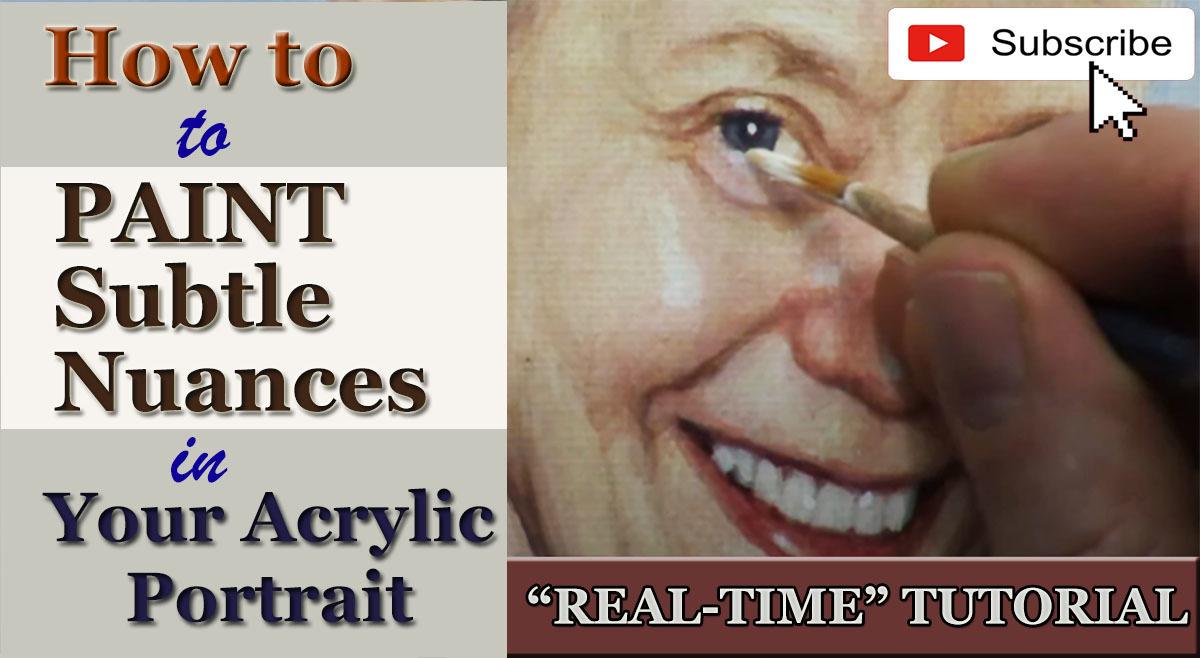
How to Paint Subtle Nuances in Your Acrylic Portrait
Discover how to add depth, light, and subtle details to your acrylic portrait, enhancing realism and making your subject come alive with nuanced highlights.
Introduction: Why Nuances Matter in Portrait Painting
Portrait painting is more than just capturing the basic features of a subject. Then to make your portrait stand out and come to life, subtle nuances small highlights, color shifts, and light reflections are essential. Because these elements help convey depth, texture, and form, making your painting more dynamic and realistic. In this tutorial, we will break down how to achieve these nuances using acrylic paint, with a special focus on adding highlights to the face, hair, and eyes of your subject.
In this case, I’ll walk through applying nuanced highlights to a 16×20 acrylic portrait, focusing on a woman’s face. These techniques can be applied to any portrait to bring out delicate details that make a big impact.
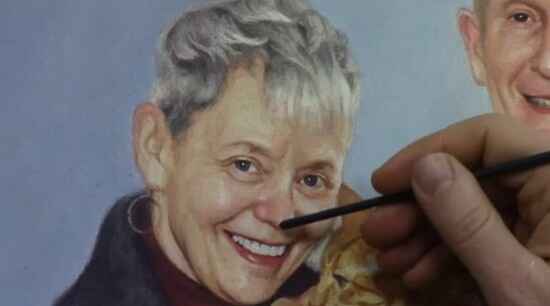
Materials Needed:
- Acrylic Paints: Titanium White, Indian Yellow, alizarine crimson
- Brushes: Size 2 round brush
- Matte Medium: For blending and creating smooth transitions
- Reference Image: Helps maintain accuracy in light and detail placement
Step-by-Step Guide: Adding Highlights and Nuances
1. Prepare Your Palette
Start by mixing your colors then of course to achieve natural, warm highlights, mix a small amount of titanium white with indian yellow. This combination softens the brightness of white while introducing warmth that complements the skin tones. And then add matte medium to create a fluid consistency, allowing the paint to glide smoothly over your canvas without overwhelming the underlying layers.
2. Highlight the Eyes
When eyes are often the focal point of a portrait so you need to begin by adding subtle highlights to the eyelid fold. When sing the fine point of a size 2 round brush, you need to carefully apply your light mixture to the upper eyelid. Because this touch of light creates dimension and reflects the light source, adding realism to the gaze.
Also, be mindful of your reference photo. Because small highlights in the right places like the inner corner of the eye or along the eyelid an make the eyes appear brighter and more expressive.
Tip: If the paint feels too opaque, mix in more matte medium. Because this technique ensures the highlight blends naturally into the surrounding areas, avoiding any harsh lines.
3. Add Nuances to the Nose
The nose is another critical area for creating form. In this portrait, the nose already has a foundation for highlights that were preserved during previous glazing steps. Then now, gently place a pinpoint highlight on the bridge and tip of the nose, where the light naturally falls. Use small, controlled strokes to build up the light gradually.
Blend the edges of this highlight with the surrounding skin tones by feathering it out with a bit of matte medium, creating a soft, diffused transition.
4. Accent the Cheeks and Chin
The next step involves bringing more light to the cheekbones and chin. These areas are key for defining the structure of the face. Use the same warm highlight mixture and lightly touch the upper areas of the cheeks. Ensure that these highlights are subtle—they should enhance the natural contours without overpowering the mid-tones.
Similarly, add a soft highlight to the chin to round out the lighting scheme. Small, strategic highlights like these give your portrait dimension and balance.
Techniques for Blending and Softening
1. Diffusing the Highlights
After applying your highlights, it’s essential to soften the transitions between light and shadow. When using a clean brush or one slightly loaded with matte medium, it gently fan out the edges of your highlights. This technique ensures that the light appears natural and seamless rather than harsh or abrupt.
For instance, after applying a highlight to the nose, use a dry brush to diffuse the edges, pulling the light into the surrounding areas. This makes the highlight feel integrated rather than sitting starkly on the surface.
2. Layering for Depth
Acrylic paint allows you to layer thin glazes to build up depth gradually. This is particularly useful for refining your highlights. Start with a soft base highlight, and as it dries, return with a slightly thicker mixture of Titanium White to emphasize the center of the light. This creates a three-dimensional effect, making certain features like the nose or cheekbones pop.
Final Touches: Enhancing Hair and Fine Details
1. Adding Highlights to the Hair
To add subtle nuances to the hair, use the same highlight mixture but with more Titanium White for contrast. Just focus on the areas where the light source hits the hair typically the top of the head and along strands that curve outward.
When you apply short, controlled strokes to simulate the texture of hair. Make sure to vary the pressure and direction of your brushstrokes to avoid a flat appearance. Highlights on the hair should complement the overall lighting scheme of the portrait, pulling everything together.
2. Refining Details on the Lips and Chin
For the final touches, go back to smaller areas like the lips and chin. A soft vertical highlight on the lower lip can create a sense of moisture and volume. Similarly, a light stroke across the chin can round out the lower half of the face. At this stage, check your reference photo again to ensure the highlights align with the overall light source.
Conclusion: Nuances Make the Difference
By focusing on subtle highlights and careful layering, you can transform a flat portrait into a vibrant, lifelike piece of art. The nuances you add—whether it’s a soft glow on the cheek or a pinpoint light in the eyes—are what make your portrait feel real. These small touches can elevate your painting and give it the professional finish you’re looking for.
Remember, practice makes perfect. Don’t be afraid to experiment with different levels of brightness and blending techniques to find the balance that works best for your subject. And always take time to step back and assess the overall effect of your nuances.
- Adding highlights to your acrylic painting
- 5 Excellent Reasons to Use Aluminum Foil
- Paint Realistic Wrinkles in Acrylic
- Painting Clothing in an Acrylic Portrait
- Paint a Cloudy Sky Acrylic
- How to add Semi-Opaque Highlights
- How to Enhance the Contrast in Your Acrylic
- How to Add Glaze to Your Acrylic Painting
- Paint Realistic Reflections on Eyeglasses in an Acrylic Portrait
- Build Up Depth on Your Acrylic Portrait Backgrounds
- How Do You Do Layers With the Glazing Technique?
- Learn How to Paint Wrinkles in Acrylic
Read more about how to paint a portrait that you can surely be proud of!
I’d love to hear your thoughts about this video. Please share it with your friends and family. Let me know if you have any further questions. I’ll greatly help you.
If you’d like to learn more, sign up for my free email tips and video class today.
Learn How to Paint Acrylic Portraits With My Free Mini-Video Course!
Thank you so much for taking the time to read this tutorial and watch the video. That means a lot to me. I hope you find it very helpful in your portrait painting.

P.S. Did you find this post helpful or encouraging? If so, send it on ahead! Let others know with the share buttons below. I’d love to hear your comments. Thank you so much! Also, do you have a question on acrylic portrait painting you’d like answered? Let me know, and I’d be happy to help!
